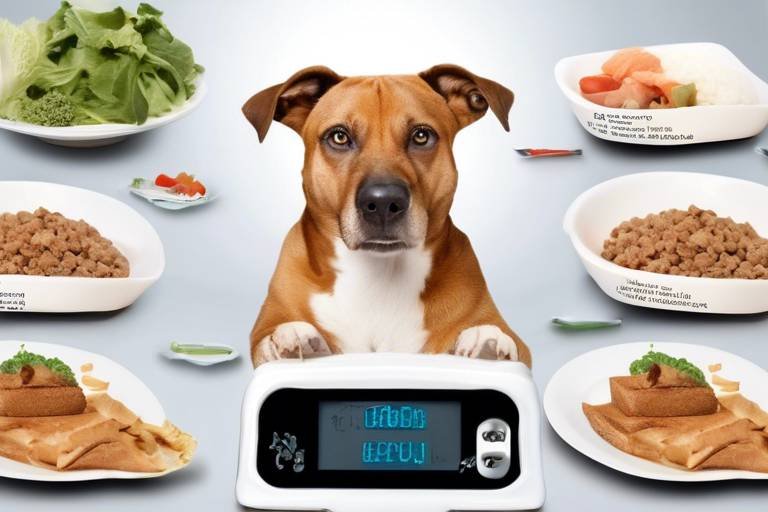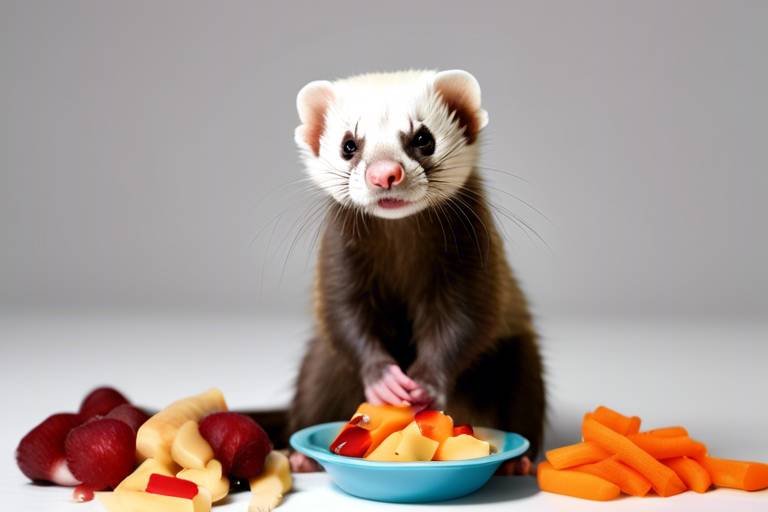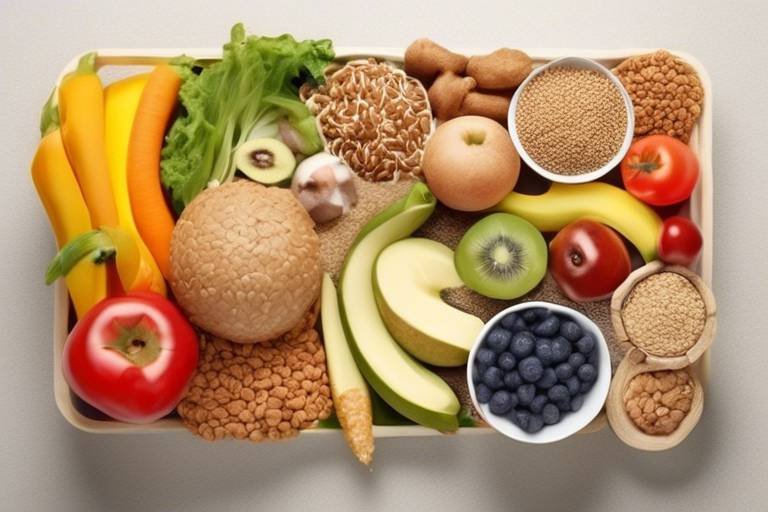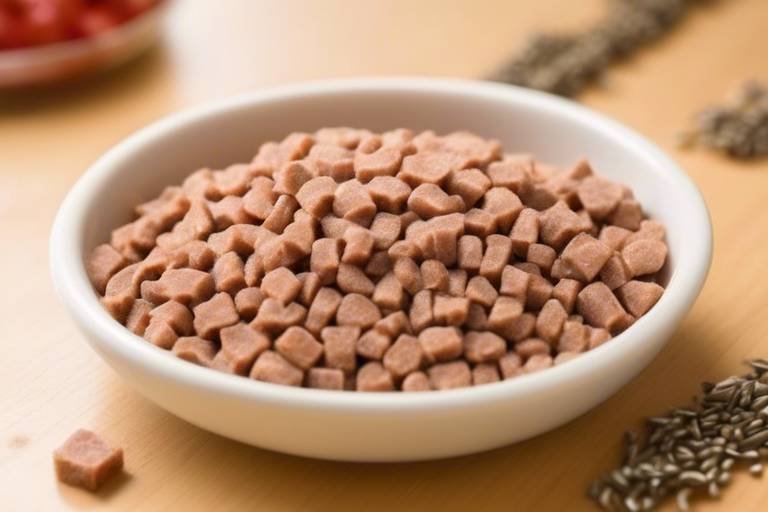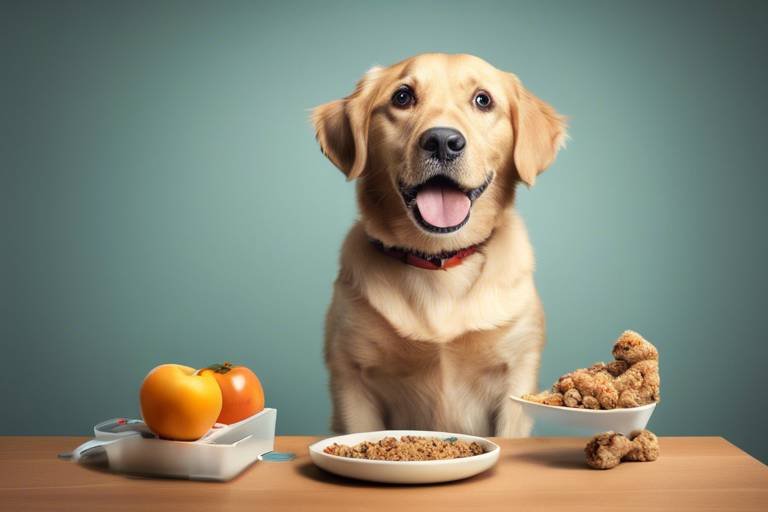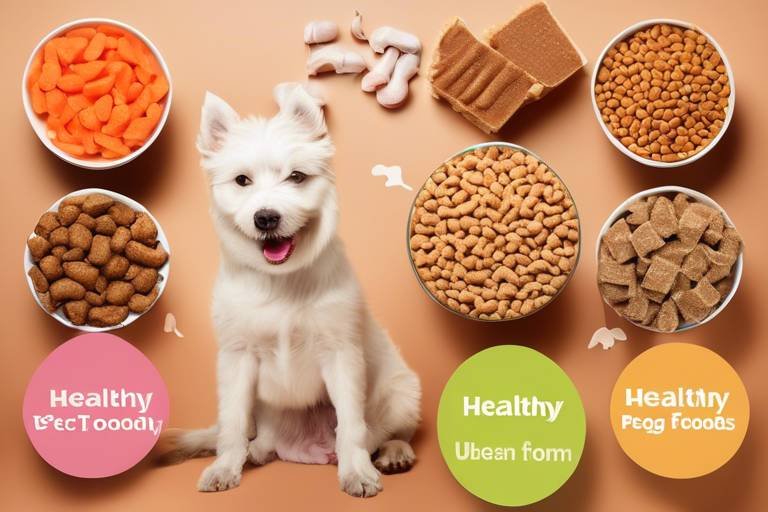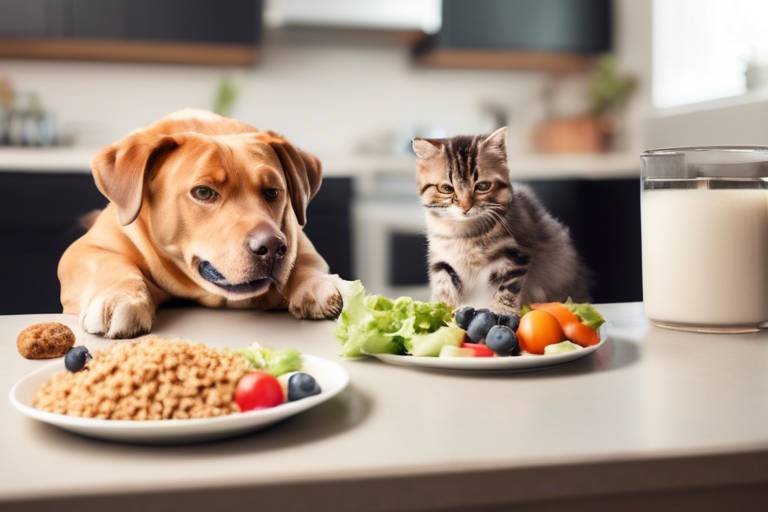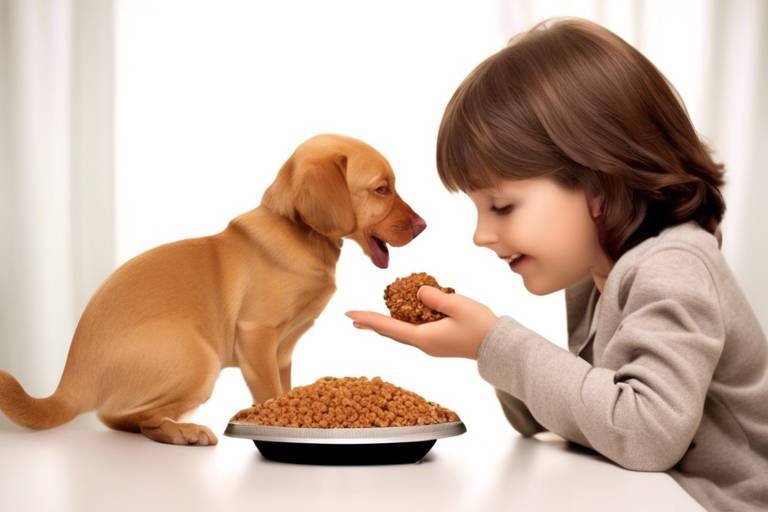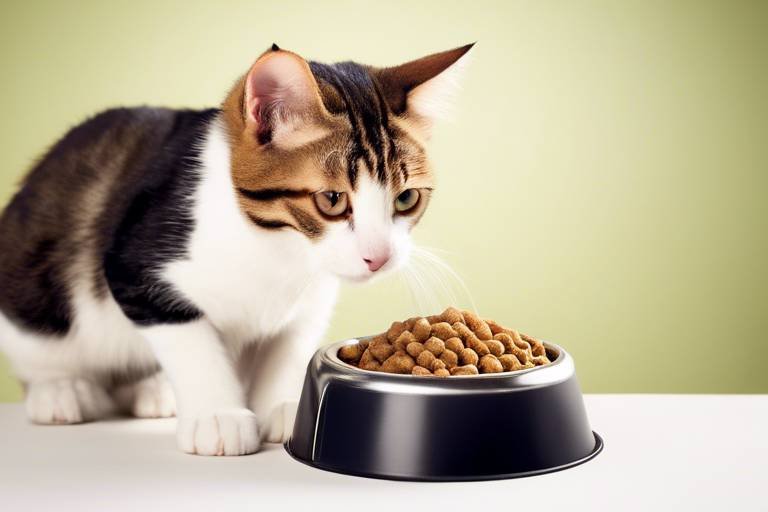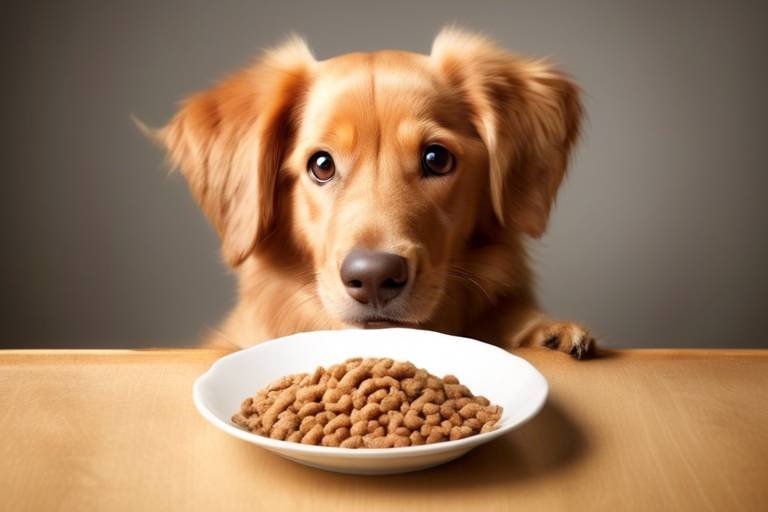The Role of Meal Frequency in Pet Health
As pet owners, we often find ourselves pondering the best ways to keep our furry friends happy and healthy. One crucial aspect that can significantly impact their well-being is meal frequency. The way we feed our pets—how often and how much—can affect their overall health, energy levels, and even their emotional state. In this article, we will explore the various feeding schedules available, their benefits, and practical tips for ensuring that our pets receive optimal nutrition.
Meal frequency refers to how often pets are fed throughout the day. It’s not just about filling their bowls; it’s about understanding the significance of these feeding habits in maintaining a pet's health and energy levels. Some pet owners may choose to feed their pets once a day, while others may opt for two or three meals. Each approach has its implications on digestion, energy management, and even behavioral issues. Think of it like this: just as humans feel better when they have regular meals, our pets thrive on a routine that keeps them nourished and satisfied.
Regular feeding can lead to a plethora of benefits for our pets, including improved digestion, stable energy levels, and better weight management. By establishing a consistent feeding schedule, we can help our pets avoid the rollercoaster of hunger and fullness that can lead to health issues. Imagine trying to work on an empty stomach; it’s tough, right? The same goes for our pets!
Feeding pets at regular intervals can enhance their digestive health. Just as we benefit from a balanced diet spread throughout the day, our pets do too. When we feed them consistently, their gastrointestinal systems can function more efficiently, leading to better nutrient absorption. This means that the food they eat is more likely to translate into energy and vitality, keeping them active and playful.
Establishing a set feeding schedule can also help prevent overeating, which is crucial for maintaining a healthy weight. Overeating can lead to obesity, which is a significant concern for many pets. To manage portion sizes effectively, consider using a measuring cup to ensure that you’re providing the right amount of food. This practice not only helps in controlling their weight but also promotes a healthier lifestyle.
A consistent feeding routine can reduce anxiety in pets, providing them with a sense of security. Pets thrive on predictability, and knowing when their next meal is coming can alleviate stress. Think of it as a comforting ritual that gives them something to look forward to. This predictability can foster a sense of calm, making your pet feel more secure in their environment.
There are various feeding schedules pet owners can adopt, including free feeding and scheduled feeding. Free feeding allows pets to graze throughout the day, while scheduled feeding provides specific meal times. Each method has its advantages and disadvantages:
| Feeding Method | Advantages | Disadvantages |
|---|---|---|
| Free Feeding | - Convenience - Allows pets to eat when hungry |
- Risk of overeating - Difficult to monitor food intake |
| Scheduled Feeding | - Better weight management - Easier to monitor health |
- Requires more effort - May lead to begging behavior |
Young animals have unique nutritional needs that are crucial for their development. Meal frequency is especially important for puppies and kittens, as their growth and energy requirements are significantly higher than those of adult pets. A well-structured feeding schedule can ensure that they receive the necessary nutrients to grow strong and healthy.
Understanding the different growth stages of puppies and kittens is essential for determining appropriate meal frequency. For instance, puppies typically require more frequent meals than adult dogs because they are growing rapidly. As they transition from puppyhood to adulthood, their feeding needs will change.
As pets mature, their feeding requirements evolve. It’s important to know when and how to transition from puppy or kitten feeding schedules to adult feeding routines. This transition should be gradual to avoid digestive upset. Monitoring your pet’s weight and energy levels during this transition can help ensure they are receiving the right nutrition at every stage of their life.
- How often should I feed my adult dog? Most adult dogs do well with two meals a day, but it can vary based on their size and activity level.
- Can I free feed my cat? Some cats do well with free feeding, but it’s important to monitor their weight to avoid obesity.
- How do I know if my pet is overweight? You should be able to feel your pet's ribs without excess fat covering. If you're unsure, consult your veterinarian.
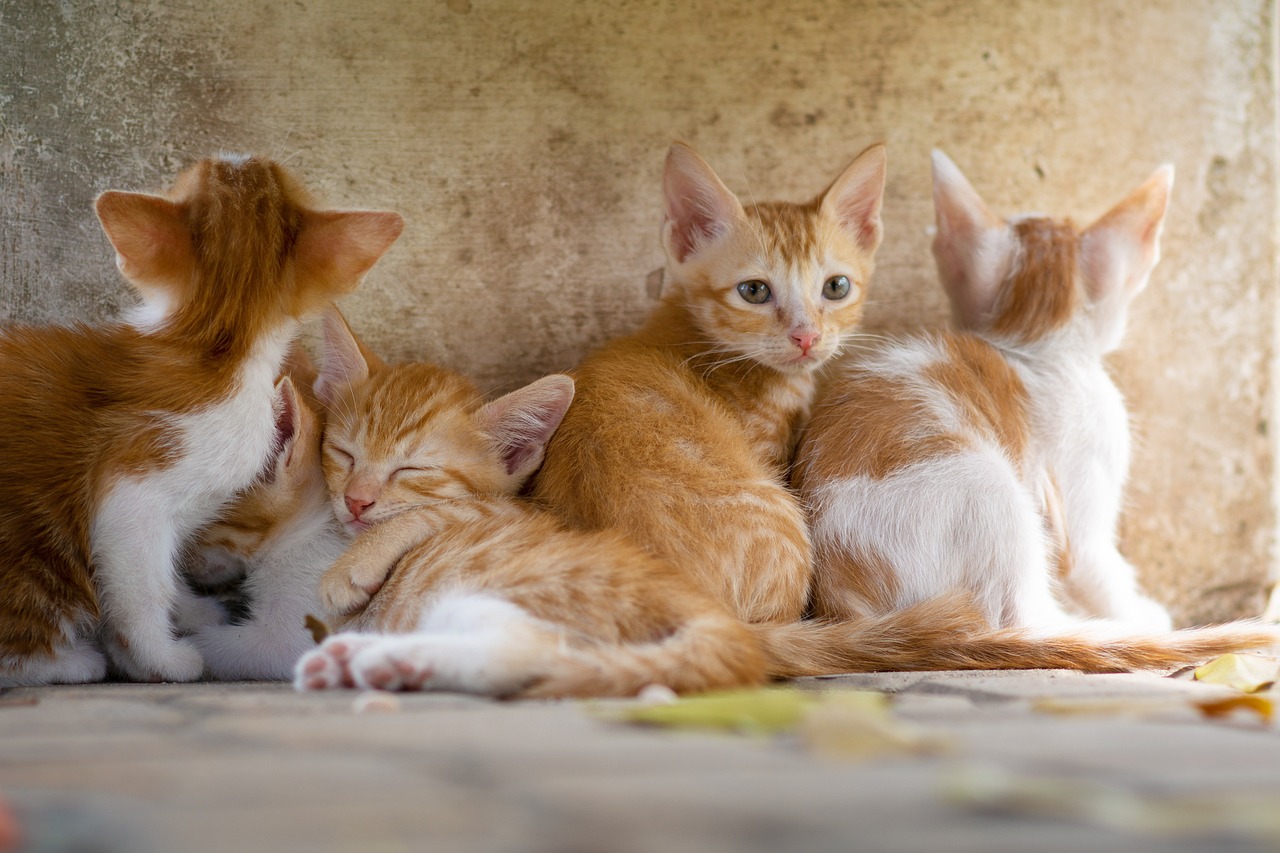
Understanding Meal Frequency
Meal frequency is more than just a fancy term for how often you feed your pet; it's a crucial aspect of their overall health and well-being. Think of it like setting a rhythm to their day, much like a well-timed clock. Just as humans thrive on routine, our furry friends benefit immensely from having consistent meal times. So, what does meal frequency really entail? It refers to the number of meals your pet consumes within a 24-hour period. This can vary widely based on factors like age, size, activity level, and specific health needs.
For example, puppies and kittens often require more frequent meals than adult pets because they are growing rapidly and need constant energy to fuel their development. On the other hand, adult pets may thrive on two to three meals a day. But, is there a one-size-fits-all approach? Absolutely not! Each pet is unique, and their meal frequency should be tailored to their individual needs. A good starting point is to consult with your veterinarian, who can provide personalized recommendations based on your pet's specific circumstances.
Many pet owners might wonder about the impact of meal frequency on their pet's energy levels. Well, imagine your pet as a high-performance vehicle. Just like a car needs the right fuel at the right intervals to run smoothly, pets need regular meals to maintain optimal energy levels throughout the day. If they go too long without food, they might experience dips in energy, leading to lethargy or irritability. Conversely, feeding them too frequently could lead to obesity and other health issues. It's all about finding that sweet spot!
Furthermore, meal frequency can also influence your pet's behavior and emotional state. A predictable feeding schedule can give pets a sense of security, reducing anxiety and stress. They begin to associate certain times of the day with food, which can create a comforting routine. This predictability is especially beneficial for pets that may be prone to anxiety or behavioral issues.
In summary, understanding meal frequency is essential for ensuring that your pet receives the right nutrition at the right times. It's about striking a balance that supports their physical health while also catering to their emotional needs. So, whether you're feeding a rambunctious puppy or a laid-back adult cat, remember that meal frequency plays a vital role in their overall well-being.
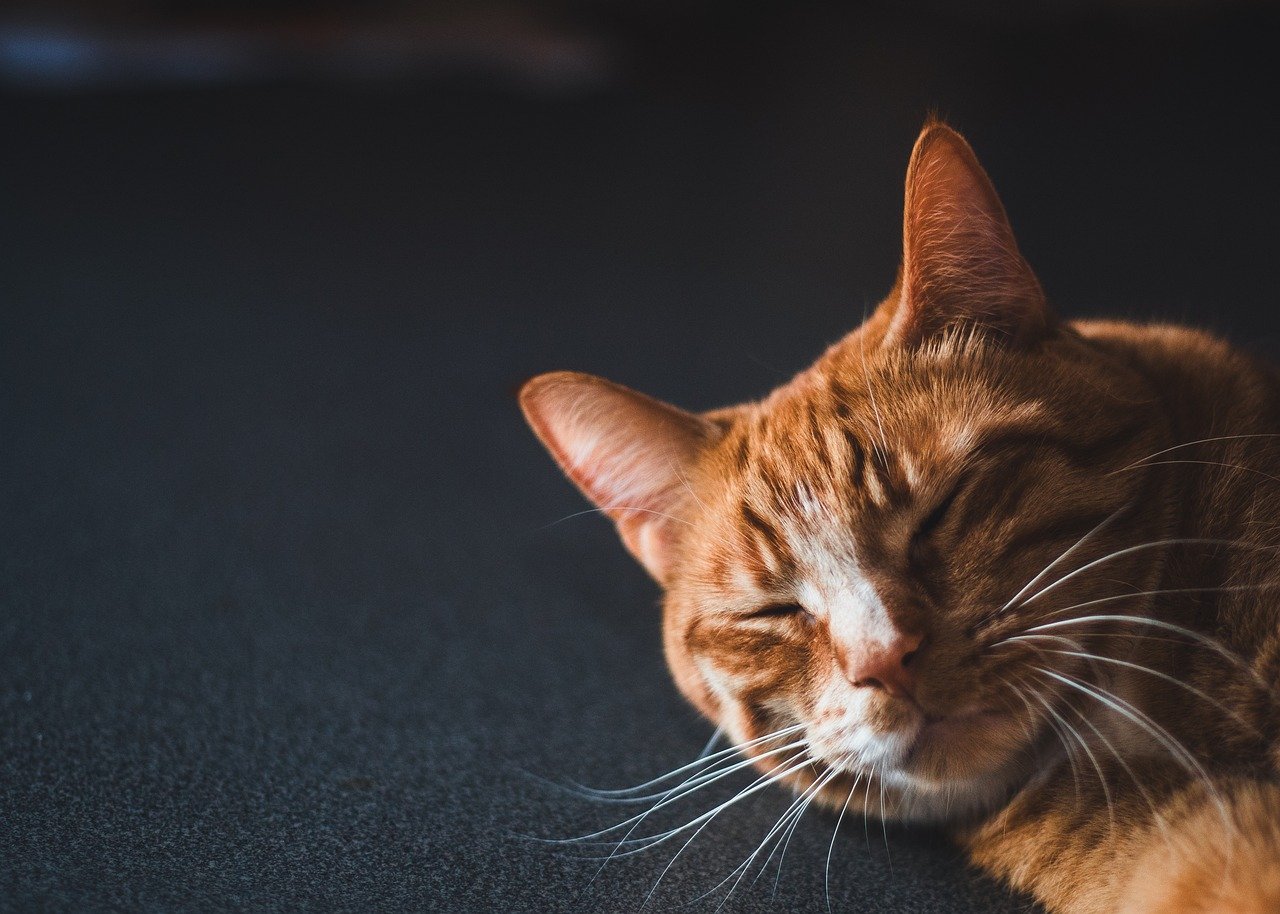
Benefits of Regular Feeding
When it comes to keeping our furry friends happy and healthy, the timing of their meals plays a crucial role. Regular feeding schedules can significantly influence your pet's overall well-being, and understanding these benefits is essential for every pet owner. Imagine if you had to eat whenever you felt like it—chaotic, right? Pets thrive on routine, and establishing consistent meal times can lead to a variety of positive outcomes.
One of the most notable benefits of regular feeding is improved digestion. Just like humans, pets have digestive systems that function best when they receive food at predictable intervals. By providing meals at the same times each day, you help their bodies anticipate when to process food, leading to better gastrointestinal function. This predictability can enhance nutrient absorption, ensuring that your pet gets the most out of their meals. Think of it as setting a clock for their stomachs; when the clock strikes meal time, everything runs smoothly!
Another significant advantage is the impact on weight management. Overeating is a common issue among pets, often leading to obesity and related health problems. By establishing a feeding schedule, you can control portion sizes and prevent your pet from grazing throughout the day. For instance, if you feed your dog twice a day, they’ll learn to expect those meals and won’t feel the need to scavenge for extra food. This routine not only helps maintain a healthy weight but also promotes a balanced metabolism. Here’s a simple table to illustrate this:
| Feeding Method | Benefits | Drawbacks |
|---|---|---|
| Scheduled Feeding | Improved digestion, better weight management | Requires discipline from pet owners |
| Free Feeding | Convenient for owners | Increased risk of overeating and obesity |
Moreover, regular feeding can also reduce anxiety in pets. Animals thrive on predictability, and a consistent feeding routine provides them with a sense of security. When pets know that they will be fed at specific times, they can relax and feel more at ease. This is particularly important for pets that may have experienced instability in their past, as a reliable schedule can help them feel safe and secure in their new environment. Think of it as a comforting ritual that reassures them they are loved and cared for.
In conclusion, the benefits of regular feeding extend far beyond just filling your pet’s belly. From promoting better digestion and weight management to reducing anxiety, a consistent feeding schedule can transform your pet's health and happiness. So, if you haven’t already, consider establishing a routine that works for both you and your furry companion. Remember, a happy pet is a healthy pet!
Impact on Digestion
When it comes to the health of our furry friends, digestion plays a crucial role. Just like us, pets thrive on a well-regulated feeding schedule. Imagine your pet's stomach as a finely tuned engine; if you feed it irregularly, it can lead to a host of problems. Regular meal frequency ensures that their digestive system operates smoothly, allowing for optimal nutrient absorption and overall health.
Feeding pets at consistent intervals can significantly enhance their gastrointestinal function. For instance, when pets eat at the same times each day, their bodies become accustomed to processing food efficiently. This predictability helps in the production of digestive enzymes and bile, which are necessary for breaking down food. In contrast, irregular feeding can lead to digestive issues such as bloating, gas, and even diarrhea.
Furthermore, a consistent feeding schedule can help prevent overeating. When pets are free-fed—having food available all day—they may eat out of boredom or anxiety rather than hunger. This can lead to obesity and other related health issues. By establishing a set feeding schedule, you can monitor your pet's portion sizes more effectively, ensuring they receive the right amount of food for their size and energy levels.
To illustrate the importance of meal frequency on digestion, consider the following table:
| Feeding Schedule | Digestive Impact | Potential Issues |
|---|---|---|
| Scheduled Feeding | Improved enzyme production, consistent digestion | Lower risk of obesity |
| Free Feeding | Irregular digestion, potential for overeating | Higher risk of obesity and digestive disorders |
As you can see, the choice of feeding schedule can have a profound impact on your pet's digestive health. A regular feeding routine not only enhances digestion but also contributes to a healthier weight and a happier pet. So, if you want to keep your furry companion in tip-top shape, consider adopting a consistent meal plan that suits their needs.
Preventing Overeating
Establishing a consistent feeding schedule for your pets is not just a matter of routine; it’s a vital strategy for preventing overeating. Overeating can lead to a myriad of health issues, including obesity, diabetes, and digestive problems. Just like us, pets can struggle with portion control, especially when food is readily available. By implementing a structured feeding routine, you can help your furry friends maintain a healthy weight and overall well-being.
One effective way to manage portion sizes is by using a measuring cup to ensure that you’re serving the correct amount of food for your pet’s size and activity level. You wouldn’t want to fill a bowl to the brim and let your pet eat as much as they want, would you? Think of it as a buffet where you control the portions; this way, your pet enjoys their meals without going overboard.
Additionally, consider using puzzle feeders or slow-feed bowls. These innovative tools can turn mealtime into a fun activity while also slowing down your pet’s eating pace. It’s like giving them a puzzle to solve while they munch away! Not only does this help prevent overeating, but it also stimulates their minds, keeping them engaged and entertained.
Another key aspect to consider is the timing of meals. Feeding your pet at the same times each day creates a routine that they can anticipate. This predictability helps regulate their hunger signals, making them less likely to beg for food outside of mealtimes. Just like how we feel hungry when we know it’s lunchtime, pets thrive on routine and will learn to expect their meals at specific times.
Lastly, be mindful of treats. Treats can easily add up and contribute to excessive calorie intake. Instead of using treats as a reward for every little thing, consider reserving them for special occasions or training sessions. This not only reinforces good behavior but also helps keep your pet’s diet in check.
In summary, preventing overeating in pets requires a combination of structured feeding schedules, portion control, engaging feeding tools, and mindful treat management. By taking these steps, you can ensure your pet enjoys their meals while staying healthy and happy.
- How often should I feed my pet? - It generally depends on the age and size of your pet. Puppies and kittens require more frequent meals than adult pets.
- Can I free-feed my pet? - While some pets can manage free feeding, it can lead to overeating in others. It's often better to have set meal times.
- What should I do if my pet is overweight? - Consult your veterinarian for a tailored weight loss plan, which may include portion control and increased exercise.
Reducing Anxiety
Just like humans, our furry friends can experience stress and anxiety. Imagine coming home after a long day, only to find your pet pacing around the room, unsure of when their next meal will arrive. This uncertainty can lead to feelings of insecurity, which is why establishing a consistent feeding routine is crucial. When pets know exactly when to expect their meals, it creates a sense of predictability in their lives.
Feeding your pet at the same time every day can significantly reduce their anxiety levels. Think of it as setting a clock for their stomachs; they start to associate specific times with food and comfort. This routine not only helps them feel secure but also fosters a deeper bond between you and your pet. After all, who doesn’t love a reliable schedule? It’s like having a personal assistant who ensures you never miss a meal!
Additionally, a consistent feeding schedule can help mitigate behavioral issues often linked to anxiety, such as excessive barking, destructive chewing, or even house soiling. When pets are anxious, they may resort to these behaviors as a way to cope. By providing a structured feeding time, you can help alleviate some of that anxiety and promote a more relaxed atmosphere at home.
It's also important to consider the environment in which your pet eats. A calm and quiet space can enhance their mealtime experience, further reducing anxiety. You can create a feeding area that’s free from distractions, such as loud noises or other pets vying for attention. This way, your pet can enjoy their meal in peace, allowing them to focus on their food rather than their worries.
Moreover, the type of food you provide can also play a role in reducing anxiety. Some pet foods are specifically formulated with ingredients that promote relaxation and calmness. For example, foods containing tryptophan or omega-3 fatty acids may help soothe your pet’s nerves. If you're considering switching your pet’s diet, consult with your veterinarian to find the best options tailored to their needs.
In summary, a consistent feeding schedule not only benefits your pet's physical health but also plays a vital role in their emotional well-being. By establishing a routine and creating a serene feeding environment, you can help your furry companion feel more secure and less anxious. Remember, a happy pet is a healthy pet!
- How often should I feed my pet? - This depends on your pet's age, size, and dietary needs. Generally, adult pets can be fed once or twice a day, while puppies and kittens may require more frequent meals.
- What are the signs of anxiety in pets? - Signs may include excessive barking, destructive behavior, hiding, or changes in eating habits. If you notice these behaviors, it may be time to reassess your pet's routine.
- Can changing my pet's feeding schedule cause anxiety? - Yes, sudden changes can lead to confusion and stress. It's best to transition gradually and maintain consistency to help your pet adjust.
- What should I do if my pet refuses to eat? - Consult your veterinarian to rule out any health issues, and consider evaluating their feeding environment and schedule for potential stressors.
Different Feeding Schedules
When it comes to feeding our furry friends, the schedule we choose can significantly influence their health and happiness. There are primarily two feeding schedules that pet owners often consider: free feeding and scheduled feeding. Each method has its own set of advantages and disadvantages, and understanding these can help you make the best choice for your pet's unique needs.
Free feeding allows pets to graze on their food throughout the day, providing them with constant access to food. This method can be convenient for pet owners with busy schedules, as it eliminates the need for strict feeding times. However, it can lead to some challenges. For instance, if your pet is prone to overeating, free feeding might contribute to obesity. Moreover, it can be difficult to monitor how much your pet is actually eating, which can complicate health assessments.
On the other hand, scheduled feeding involves setting specific times during the day for your pet to eat. This method allows you to control portion sizes more effectively, which is crucial for maintaining a healthy weight. Scheduled feeding can also promote better digestion, as pets are more likely to have a regular routine that aligns with their natural eating patterns. For instance, dogs and cats are instinctively wired to hunt and eat at certain times, so a structured feeding schedule can mimic this natural behavior.
To help you weigh the pros and cons of each feeding schedule, here’s a quick comparison:
| Feeding Schedule | Advantages | Disadvantages |
|---|---|---|
| Free Feeding |
|
|
| Scheduled Feeding |
|
|
Ultimately, the choice between free feeding and scheduled feeding depends on your pet's individual needs, lifestyle, and health considerations. For example, if you have a young, energetic puppy, a scheduled feeding routine might work best to ensure they get the right nutrients at the right times. Conversely, if you have an older cat who prefers to nibble throughout the day, free feeding might be a more suitable option.
Whichever method you choose, the key is to maintain consistency and monitor your pet's weight and overall health. Regular vet check-ups can also help you assess whether the feeding schedule you’ve chosen is working well for your furry companion.

Feeding Puppies and Kittens
Feeding puppies and kittens is not just about filling their bowls; it’s about understanding their unique nutritional needs at different stages of their rapid growth. These young animals are like little sponges, soaking up everything they need to grow strong and healthy. As a pet owner, you have the incredible responsibility of ensuring that their diet supports their development, which can be both exciting and a bit overwhelming. So, how do you navigate this crucial aspect of pet care?
When it comes to puppies and kittens, meal frequency plays a pivotal role. Unlike adult pets, who can thrive on two meals a day, young pets typically require more frequent meals. This is because their stomachs are smaller, and they need a constant supply of nutrients to fuel their energetic play and growth spurts. Generally, puppies should be fed three to four times a day, while kittens can also benefit from a similar feeding schedule. This approach not only helps in meeting their caloric needs but also aids in maintaining stable energy levels throughout the day.
As these little furballs grow, their meal frequency will need to be adjusted. For instance, puppies will gradually transition to fewer meals as they approach adulthood. By around six months of age, many puppies can be fed twice a day. Similarly, kittens may also shift to two meals a day by the time they reach six months. It’s crucial to monitor their growth and adjust their feeding schedules accordingly, ensuring they are neither overfed nor underfed.
Here’s a quick overview of the recommended feeding frequencies for puppies and kittens:
| Age | Puppies (Meals per Day) | Kittens (Meals per Day) |
|---|---|---|
| 0-4 Months | 4 Meals | 4 Meals |
| 4-6 Months | 3 Meals | 3 Meals |
| 6-12 Months | 2 Meals | 2 Meals |
Feeding your young pets is not just about quantity; quality matters too! Opt for high-quality, age-appropriate food that provides the right balance of protein, fats, and carbohydrates. Always check the label for essential nutrients like DHA for brain development, calcium for bone growth, and antioxidants for immune support. It’s a bit like crafting the perfect recipe for success—each ingredient plays a vital role!
Transitioning to adult feeding can be another challenge. As your puppy or kitten matures, you’ll need to gradually change their diet to reflect their new needs. This transition should be done slowly, over the course of about a week, to avoid digestive upset. Mixing in their new food with the old can help them adjust without any tummy troubles. Think of it as introducing a new flavor to a beloved dish—slow and steady wins the race!
In conclusion, understanding the feeding needs of puppies and kittens is essential for their health and development. By providing the right meal frequency and quality nutrition, you are laying the foundation for a long, healthy life for your furry friends. Remember, it’s not just about feeding; it’s about nurturing their growth and ensuring they thrive!
- How often should I feed my puppy? - Puppies typically need to be fed three to four times a day until they are about six months old.
- Can I free-feed my kitten? - It's generally better to have a scheduled feeding routine for kittens to ensure they don’t overeat.
- What type of food is best for young pets? - High-quality, age-appropriate food that meets their specific nutritional needs is essential.
- When should I transition my pet to adult food? - Most puppies and kittens can transition to adult food around six to twelve months of age.
Growth Stages
Understanding the of puppies and kittens is crucial for pet owners who want to provide the best nutrition for their furry friends. Just like human children, young animals experience rapid growth and development, which means their nutritional needs change significantly as they age. During the first few weeks of life, both puppies and kittens rely entirely on their mother’s milk, which provides essential nutrients and antibodies. This initial stage is critical for building a strong immune system and ensuring healthy development.
As they transition from milk to solid food, typically around four weeks of age, their dietary needs shift dramatically. At this point, it’s essential to introduce a high-quality, nutrient-dense diet that supports their growing bodies. You might wonder, “How often should I feed my growing pet?” Well, young pets usually require more frequent meals than adults. A good rule of thumb is to feed puppies and kittens three to four times a day during their early growth stages. This frequent feeding helps maintain their energy levels and supports proper digestion, which is vital for their overall health.
Let’s break down the different growth stages and their corresponding feeding requirements:
| Age | Feeding Frequency | Notes |
|---|---|---|
| 0-4 weeks | Mother's milk only | Essential for immunity and growth |
| 4-8 weeks | 3-4 meals per day | Introduce high-quality puppy/kitten food |
| 8-12 weeks | 3 meals per day | Continue with nutrient-rich diet |
| 3-6 months | 2-3 meals per day | Transition to adult feeding schedule |
| 6 months and older | 2 meals per day | Maintain a balanced diet |
As pets grow, their energy requirements will change, and so will their feeding schedule. After the age of six months, most dogs and cats can transition to a twice-daily feeding schedule. This shift not only helps in managing their weight but also simplifies feeding routines for pet owners. However, it’s important to monitor your pet’s condition and adjust their food intake as needed.
In conclusion, understanding the growth stages of your pet and adjusting their meal frequency accordingly is vital for their health and development. By providing the right nutrition at the right time, you can help ensure that your puppy or kitten grows into a healthy, happy adult.
- How do I know if my pet is getting enough food? Monitor their weight and energy levels. If they are active and maintaining a healthy weight, they are likely getting enough nutrition.
- Can I free-feed my puppy or kitten? It's generally not recommended due to the risk of overeating. Scheduled feeding helps regulate their intake.
- What should I do if my pet refuses to eat? If your pet is consistently refusing to eat, consult your veterinarian to rule out any health issues.
Transitioning to Adult Feeding
As your beloved puppy or kitten grows, their nutritional needs will change significantly. Transitioning to an adult feeding schedule is a crucial step in ensuring that your pet remains healthy and thrives. But when is the right time to make this transition? Typically, puppies can begin transitioning around 12 months of age, while kittens may take a little longer, around 10-12 months, depending on their breed and size. This shift is not just about changing the type of food; it also involves adjusting the quantity and frequency of meals.
During the transition period, it's essential to introduce adult food gradually. A sudden change can lead to digestive upset, which is the last thing you want for your furry friend. Start by mixing a small amount of the adult food with their current puppy or kitten food, gradually increasing the proportion of adult food over a week or two. This slow introduction allows their digestive system to acclimate to the new food and helps avoid any gastrointestinal disturbances.
Here’s a simple guideline to help you transition smoothly:
| Day | Puppy/Kitten Food | Adult Food |
|---|---|---|
| 1-2 | 75% | 25% |
| 3-4 | 50% | 50% |
| 5-6 | 25% | 75% |
| 7 | 0% | 100% |
It's also important to monitor your pet's weight and overall health during this transition. Keep an eye out for any signs of discomfort, such as changes in appetite, vomiting, or diarrhea. If you notice any adverse reactions, consult your veterinarian immediately. They can provide personalized advice tailored to your pet's specific needs.
As your pet becomes accustomed to their new adult diet, you may also want to consider adjusting their feeding schedule. Adult pets typically require fewer meals per day compared to puppies and kittens. While younger animals may need three to four meals daily, most adults thrive on two meals a day. This change not only helps in managing their weight but also aligns with their energy levels, promoting a more balanced lifestyle.
In conclusion, transitioning to adult feeding is a vital part of your pet's growth journey. By being mindful of their nutritional needs and making gradual changes, you can ensure that your furry companion enjoys a healthy and happy life.
- When should I transition my puppy or kitten to adult food? Generally, puppies transition around 12 months, while kittens may take 10-12 months.
- How should I introduce adult food to my pet? Gradually mix the adult food with their current food over a week or two.
- What if my pet has digestive issues during the transition? If you notice vomiting or diarrhea, consult your veterinarian for advice.
- How many meals should my adult pet have? Most adult pets do well on two meals a day.
Frequently Asked Questions
-
What is meal frequency, and why is it important for pets?
Meal frequency refers to how often you feed your pet throughout the day. It's crucial because it impacts their digestion, energy levels, and overall health. Just like humans, pets thrive on a consistent routine, which helps them maintain a healthy weight and reduces anxiety.
-
How many meals should I feed my pet daily?
The number of meals can vary based on your pet's age, size, and health needs. Generally, adult dogs and cats do well with two meals a day, while puppies and kittens may require three to four smaller meals to support their growth.
-
What are the benefits of a regular feeding schedule?
A regular feeding schedule can improve digestion, stabilize energy levels, and help manage your pet's weight. It also creates a sense of security, reducing anxiety and behavioral issues that can arise from unpredictable feeding times.
-
Can free feeding be harmful to my pet?
Free feeding, or leaving food out all day, can lead to overeating and obesity in pets. It may also disrupt their natural hunger cues, making it harder for them to maintain a healthy weight. Scheduled feeding is often a better option for most pets.
-
How can I prevent my pet from overeating?
To prevent overeating, establish a set feeding schedule with measured portions. Use feeding toys or puzzles to slow down their eating, and avoid giving in to begging behavior between meals. This will help your pet feel satisfied without overindulging.
-
What should I consider when transitioning my pet from puppy/kitten food to adult food?
When transitioning, consider your pet's growth stage, weight, and energy levels. Gradually mix the new adult food with their puppy or kitten food over a week to avoid digestive upset. Consult your vet for personalized advice based on your pet's specific needs.
-
How does meal frequency affect a pet's emotional well-being?
A consistent meal routine can provide pets with a sense of stability and predictability, which is vital for their emotional health. When pets know when to expect their meals, it can reduce anxiety and promote a calmer demeanor.
-
Are there specific feeding schedules for different types of pets?
Yes! Different pets have varying needs. For example, small breed dogs may thrive on more frequent, smaller meals, while larger breeds might do better with fewer, larger meals. Cats often benefit from multiple small meals throughout the day to mimic their natural hunting behavior.

